Complete 7 Day Yellowstone and Grand Teton Itinerary
Geothermal pools, bison, plummeting waterfalls, grizzly bears, geysers, and granite peaks — what other place on earth holds all these natural beauties? Yellowstone and Grand Teton are two of the most impressive national parks in the US.
With populous large mammal wildlife, geothermal activity unlike anywhere else in the world, and towering peaks full of sprawling rocky mountain ecosystems, it makes sense that they are also two of the most visited parks—Yellowstone named the second most-visited national park in 2020 and Grand Teton coming in fifth.
In the itinerary for Yellowstone and Grand Teton below, you’ll find a guide with the most efficient route for hitting the best of both parks in just seven days. While you can expect crowds in these parks most of the year, this road trip itinerary will give you the clearest path to seeing the grandest attractions, with:
- hikes to the most iconic vistas
- sunrise and sunset drive routes to spot wildlife
- insider knowledge on the best places to stay each night
- and a local’s tips for additional activities to do, like renting bikes, booking fishing guides, and touring the parks via horse rides.
This Yellowstone and Grand Teton road trip is sure to check all the boxes and give you a taste of each park. Make sure to bring a camera and journal! You’re going to need them to keep track of all the magnificence you’ll see on this week-long ride.
We spent over a week in Grand Teton and Yellowstone, but thought it would be more useful for you and your trip planning to work with Scout Invie, a local writer who was born in Jackson, Wyoming, to help you plan an amazing itinerary.

Disclaimer: Some of the links in this post, like hotel links, are affiliate links, meaning at no additional cost to you, we make a little bit of money if you click through and book. That being said, we would never recommend something to you that we don’t stand behind 100%.
Where to Start & End Your Trip to Yellowstone and Grand Teton National Park
First thing’s first, where should you start and end your trip to these two parks?
We think that the best way to do it is to start at the northern end of Yellowstone (Gardiner, MT), and spend your time making your way south through Yellowstone, then into Teton, and end in Jackson.
You could also do it the opposite direction, starting in Jackson and ending in Gardiner. Or, if you’re coming from the west through Idaho, you could start at the western entrance of Yellowstone and just pick up the itinerary from there, which works out quite nicely.
The point is, we think doing it one-way is the way to go, and there are multiple ways to do it.
Doing it one-way is going to save you time by making it so you don’t have to double back, but you should also think about costs. Specifically, flight costs to fly in and out of separate airports, and one-way rental car costs if you’re flying in and renting a car to do this road trip.
There’s a decision to make here – whether you think the extra cost of those two things is worth saving several hours (probably between 4-6 at a minimum, when it’s all said and done) of driving. We think it is, which is why this itinerary is designed to go one-way.
How Many Days for this Itinerary?
We think 7 days is the perfect number of days to explore both Yellowstone and Grand Teton without feeling TOO rushed. That’s what you’ll find below.
This 7 day Yellowstone and Grand Teton itinerary is a mash up of our 4 day Yellowstone itinerary, and our 3 day Grand Teton itinerary. You’ll see the best of both parks – from hikes, to wildlife drives, to scenic vistas – but your days are going to be full.
The absolute minimum amount of time we’d recommend for this trip is five days. Split between three days in Yellowstone and two days in Grand Teton. You’ll miss some of the highlights, but it’s still doable. Anything less than that and you should choose one or the other.
Got more time? Lucky you! We have some suggestions on how to spend your extra time below the main itinerary.
Yellowstone and Grand Teton National Park Overview
Before we get into the exact 7 day itinerary below, let’s take a second to talk about the two national parks themselves.
Yellowstone National Park

Contrary to popular belief, Yellowstone isn’t the largest national park in the US. However, it’s massive. Covering 3,500 square miles, it has the largest glacial lake in North America and is also home to a spread of ecosystems, geothermal features, and wildlife not found anywhere else in the world. You definitely need to visit Yellowstone!
Highlights:
- Rise early to see wolves, grizzlies, and bison in the Lamar Valley — don’t forget your binoculars!
- Hike the strenuous path to the peak of Mt. Washburn, where firefighters stand on duty all summer to carefully watch over fifty miles of visual panoramic space.
- Take in the majesty of the misting upper and lower falls at Grand Canyon of the Yellowstone.
- Walk the boardwalks around the rainbow hotspots known as Grand Prismatic, then scale a path to get an aerial view of the springs and Old Faithful blowing sky-high.
Where to Stay in Yellowstone
Yellowstone is a massive park. So large that you could dedicate the entire week you have on this road trip just to touring Yellowstone. You’d honestly probably need two weeks to see it all.
For the sake of seeing the most attractions in just a few days, you’ll probably want to stay in a couple of different parts of the park to minimize driving. However, it’s quite competitive to find campsites or rooms in lodges, so take what you can get.
We have a whole guide on where to stay in Yellowstone to help you make the right choice. From camping to staying in the park’s lodges, that guide has a strategy for choosing the perfect home base (spoiler, it’s actually home bases) in Yellowstone National Park.
Inside the Park
Area-wise, we think you should plan to split your time between the Canyon area and either Old Faithful or the West Thumb.
These areas of the park are arguably the most popular parts though, so book campsites or lodging as early as you can to avoid competition.
You can find a list of campsites in Yellowstone and links to reservation systems through the National Park Service Camping website.
Outside the Park
We think Gardiner, MT is a good base for Lamar Valley, Mammoth, and Grand Canyon of the Yellowstone.
West Yellowstone, MT is a good base for Old Faithful and surrounding areas.
Splitting your time between these two towns right outside the park will give you a nice set of home bases for exploring the sprawling park without too much driving.
Grand Teton National Park
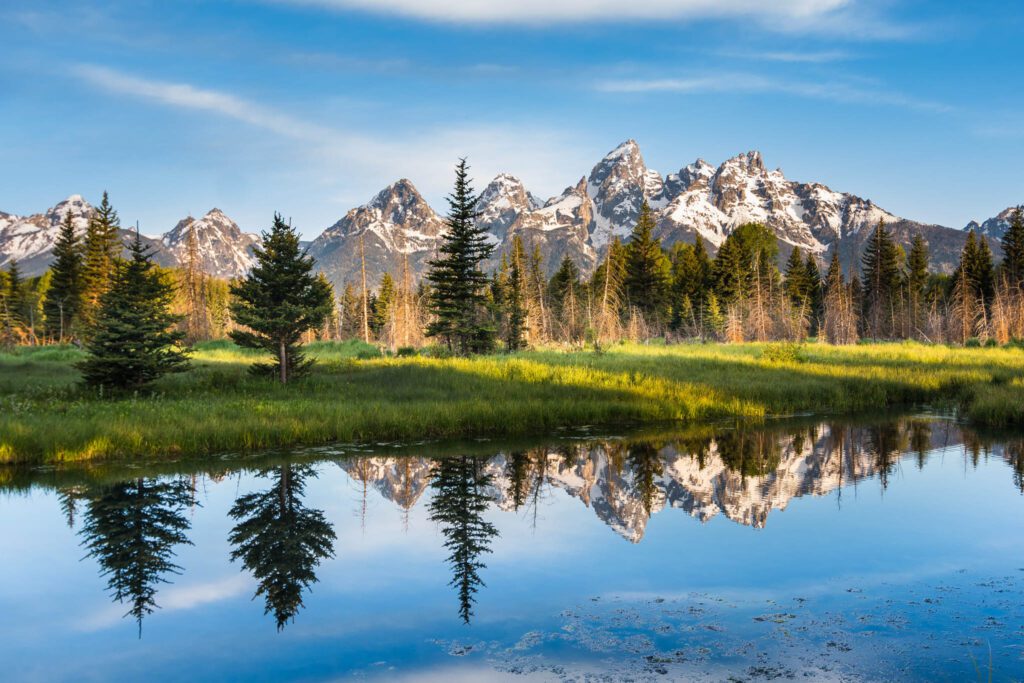
Grand Teton is a sweet, smaller park just south of Yellowstone, unique for dramatic views of the Teton Mountain Range, strenuous hikes to high-elevation glacial lakes, and prolific wildlife.
Highlights
- Catch the sunset at Oxbow Bend, a beautiful vista of the Snake River and Mt. Moran.
- Bring binoculars and look for bison in the plains behind Mormon Row.
- View the Cathedral Group of Tetons up close via Cascade Canyon.
- Hike the Phelps Lake Loop and rest at the jumping rock, a 30 foot drop into glacial water runoff.
Where to Stay in Grand Teton
Grand Teton is a much smaller park than Yellowstone. While we recommend picking multiple camp or lodge spots while traveling through Yellowstone, for Grand Teton it would probably be best to pick one site to stay in for the entirety of your trip.
Inside the Park
All campsites in Grand Teton are advance-book campsites, with the exception of 20 dispersed first-come, first-serve campsites on the Rockefeller Memorial Parkway between Yellowstone and Grand Teton. We wouldn’t necessarily recommend going for one of those spots because of how much competition there is, and because they are out of the way.
Instead, we would recommend advance booking a stay or site at Jenny Lake, Signal Mountain, or Colter Bay.
Jenny Lake
Jenny Lake Lodge: Luxury lodge located on shores of Jenny Lake, with great access to Cascade Canyon or other hikes with ferry access.
Jenny Lake Campground: Small camp a few hundred yards off the east shore of Jenny Lake. It has 61 spots, tents only, and has pay-showers nearby.
Signal Mountain
Signal Mountain Lodge: A rustic, semi-luxury lodge close to Jackson Lake, offering rooms and bungalows, as well as dining and other activities.
Signal Mountain Campsite: 81-site campground located by Signal Mountain Lodge. Accepts tents and smaller RVs. Right on the lake!
Colter Bay
Colter Bay Campground: A large 324-site camp near Jackson Lake, with spectacular views of Mt. Moran. Has many facilities located nearby.
Outside the Park
Finding accommodation in Jackson Hole is going to be your best bet. Jackson is a resort town and there are quite a few options spanning from basic sites and RV parks to luxury rentals and hotel stays.
Jackson Hole Mountain Resort (aka Teton Village) — located by the south end of the park — also has quite a few lodges and hotels. If you stay there, you can take advantage of the ski resort with the tram and gondola running during summer months to restaurants and viewpoints on the mountain.
There are also some vacation rentals around Moose, WY, if you want more space or are traveling with a larger group.
A Complete Yellowstone and Grand Teton National Park Itinerary
Without further ado, below is a guide you can feel free to reference or copy and paste for your road trip. We think this is the best way to see both parks in just seven days.
Here’s what this itinerary looks like written out.
- Day 1: Arriving, Mammoth Hot Springs, and Norris Geyser Basin
- Day 2: Wildlife Galore (Lamar + Hayden Valley) & the Grand Canyon
- Day 3: Old Faithful and Grand Prismatic Hot Springs
- Day 4: Yellowstone Lake and the West Thumb
- Day 5: Drive to Grand Teton (Mormon Row + Oxbow Bend)
- Day 6: Wildlife in Teton + Cascade Canyon
- Day 7: Rockefeller Preserve + Head Home
Additionally, here’s a map of the route you’re going to find below.
Day 1: Mammoth Hot Springs, Bunsen Peak, Norris Geyser Basin at Sunset
We’re starting off the first day of this trip with a sizzling itinerary: you’ll pass through the impressive North Entrance arch, visit the flowing limestone pools and mounds of Mammoth Hot Springs, hike through meadows and pine forests to Bunsen Peak, and see Norris Geyser Basin by sunset.
Arriving to Yellowstone’s North Entrance
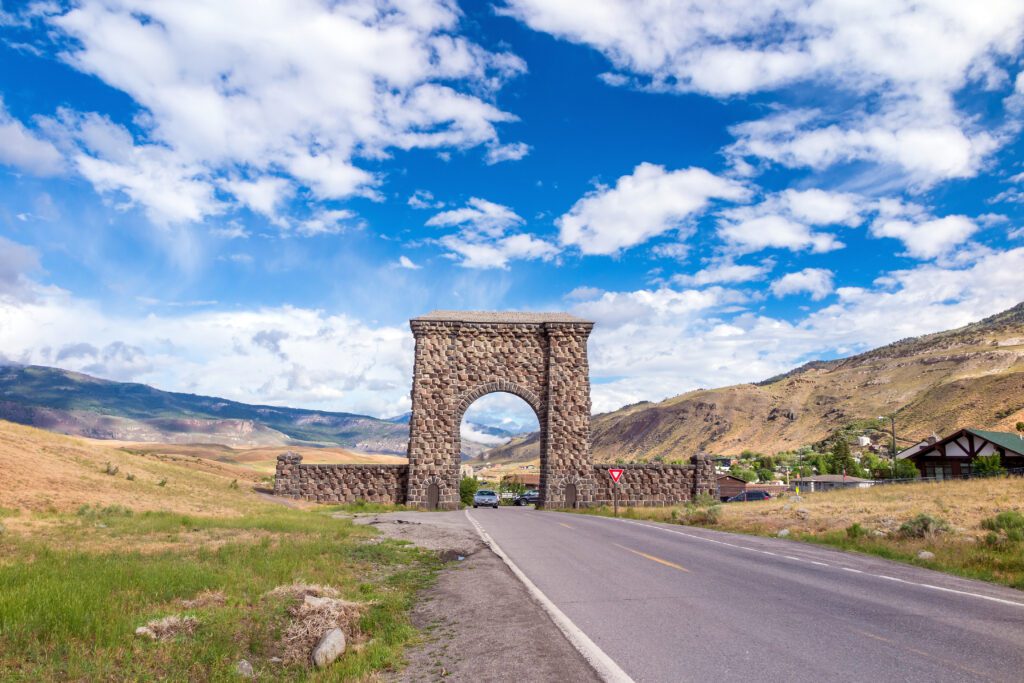
If you arrive in Bozeman on an afternoon or evening flight, we recommend finding a place to stay in the evening and then starting your journey the next morning. It will take most of the morning to get to the North Entrance of Yellowstone located in Gardiner — it’s about a 1.5 hour drive, but could be longer depending on traffic. Grab a coffee and get on the road!
Once you drive through Gardiner and pay for entrance to the park, you will pass through the Roosevelt Arch, an iconic structure built in 1903 to mark visitor’s entrance into Yellowstone. Recently, the park financed new pull-outs and sidewalks by the arch, so make sure to stop and take a picture — the first of many on this grand adventure!
Mammoth Hot Springs
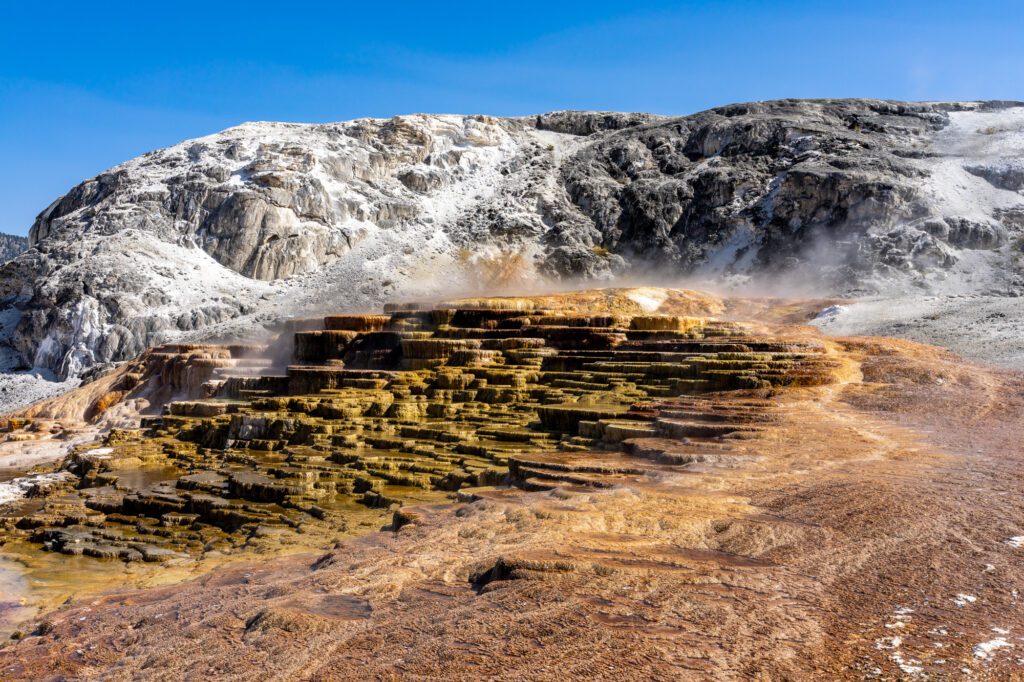
We really recommend seeing Mammoth Hot Springs as the first thing you do once entering Yellowstone. It’s a geothermal hotspot accessible by car at all times of the year, and it is iconically Yellowstone.
What you can see by stopping here: over fifty terraced hot springs, Palette Springs Terraces, and Orange Spring Mound. This otherworldly chalky-limestone landscape is a Yellowstone must-see — and you can view all of the features easily by accessing two short boardwalks from the parking lot.
Nothing is more bizarre than walking on wooden paths above steaming ground, viewing countless terraced pools and bubbling mud pools by giant orange mound geysers that resemble Wild Thing monsters. Mammoth Hot Springs makes us feel like kids again, in a constant state of curiosity and discovery.
Hike to Bunsen Peak

- Length: 4.6 miles
- Elevation Gain: 1,300 ft.
- Trail Type: Out & Back
- Difficulty: Moderate
- Trailhead Location
Bunsen Peak is a moderately-long hike that we think would be perfect right after a morning spent driving to the park and viewing Mammoth Hot Springs.
What do they say — as the crow flies? This trail is sure to make you feel part of the Yellowstone ecosystem, with a birds-eye view of Mammoth Hot Springs and Norris Geyser Basin.
And the route to the peak is just as awe-inspiring as the panoramic views up top: carpeted meadows of wildflowers in July, sweet-smelling pine forests, and ample wildlife on view ranging from marmots to bears. Make sure to bring bear spray for this one.
Norris Geyser Basin at Sunset

The hottest and most-changing spot in Yellowstone, Norris Geyser Basin is full of constantly shifting and evolving features. Two-and-a-quarter miles of trail systems give you access to the world’s tallest geyser, rainbow pools, and sulfuric-smelling air.
There are two trail loops here worth seeing. Both are pretty short and flat.
Porcelain Basin Trail
- Length: 0.75 miles
- What you’ll see: A steaming, barren landscape and milky pools accessed by boardwalk.
Back Basin Trail
- Length: 1.5 miles
- What you’ll see: A wooded area full of geysers and hot springs, accessed by a dirt trail and boardwalks.
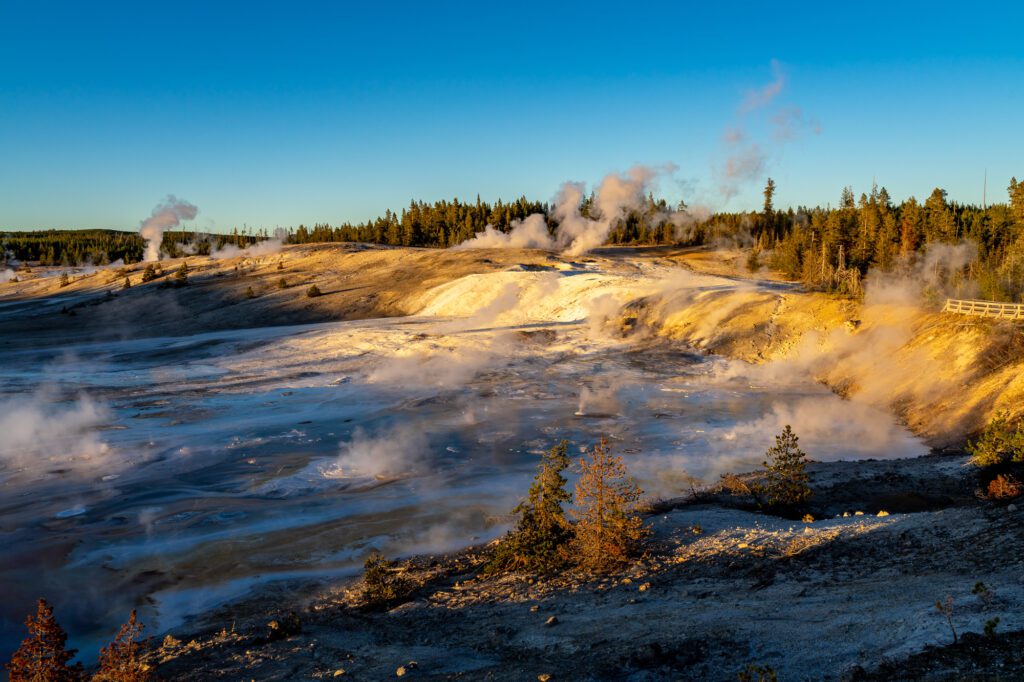
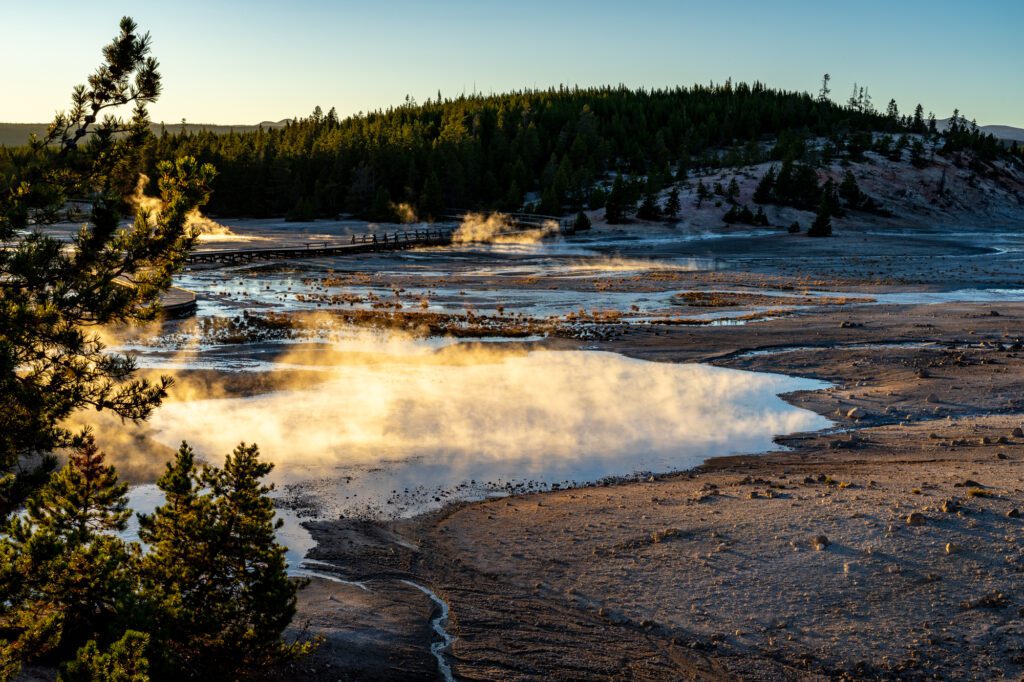
We recommend coming here at sunset for a few reasons, the first being that there will generally be way less people here during sunset, so you’ll be able to enjoy all the features for as much time as you want.
The second reason we recommend visiting at sunset: imagine the magic that happens when rainbow-colored hot springs mirror a rainbow-colored sky. The western skies are known for having intense sunsets, especially in summer. Emerald green, milky-blue, rusty orange—these are just a few of the colors you’ll be able to see not only in the hot pots, but also in the heavens. If you want to see a prismatic light show on earth and in the sky, this is the place to be!
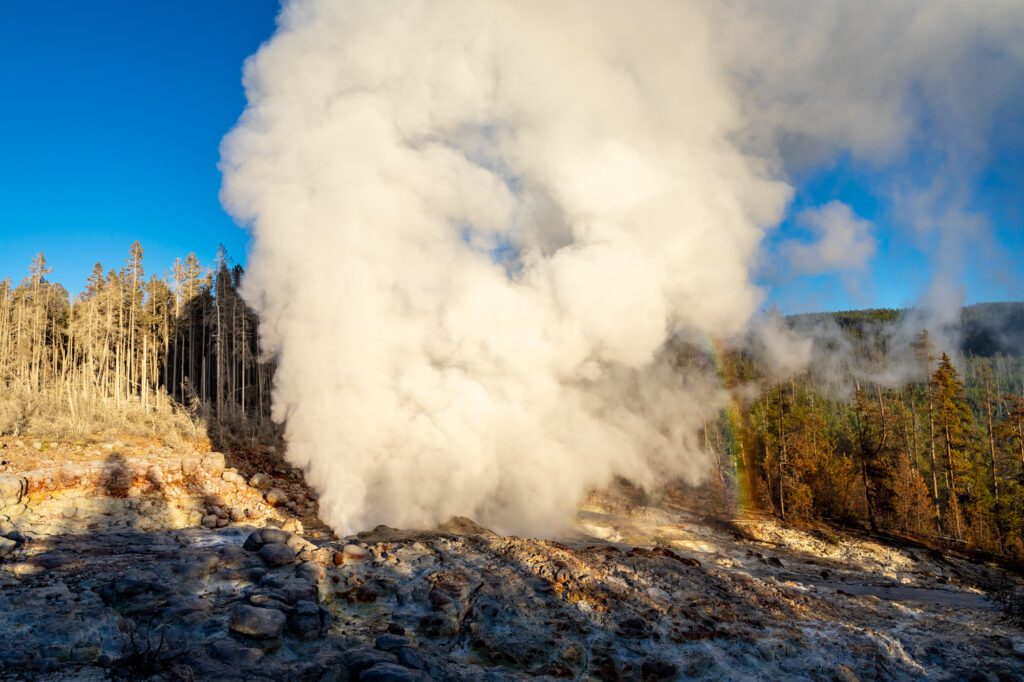
Where to Stay for the Night
To avoid further exhausting you on this packed first day of touring North Yellowstone, we recommend not trying to drive any further South. Instead, reserve a room or campsite close to Mammoth Hot Springs or backtrack the short distance (five miles) to Gardiner, MT for nicer hotels and cabin stays.
Inside the Park
- Mammoth Hot Springs Hotel: An array of cabins, rooms, and suites within the park.
- Mammoth Campground: Campsites open year-round within the park, with a shower house and picnic tables. Reservations only.
Outside the Park
- Yellowstone Gateway Inn: Modest stay located in Gardiner, MT. Offers suites and vacation rentals with river views—convenient access to grocery stores, restaurants, and other amenities in the town of Gardiner.
- Yellowstone Riverside Cottages: Highly-rated cottages overlooking the Yellowstone River. Conveniently located close to food and other amenities in Gardiner, MT.
Day 2: Wildlife, Mt. Washburn, and the Grand Canyon of the Yellowstone
On the second day of this itinerary for Yellowstone and Grand Teton, you’ll be on the lookout for packs of wolves at dawn, hiking to Mt. Washburn by mid-morning, seeing the Grand Canyon and falls of Yellowstone during the golden afternoon, and looking over herds of bison and the deepening vista of Hayden Valley at dusk.
Wolf-spotting at Dawn in Lamar Valley
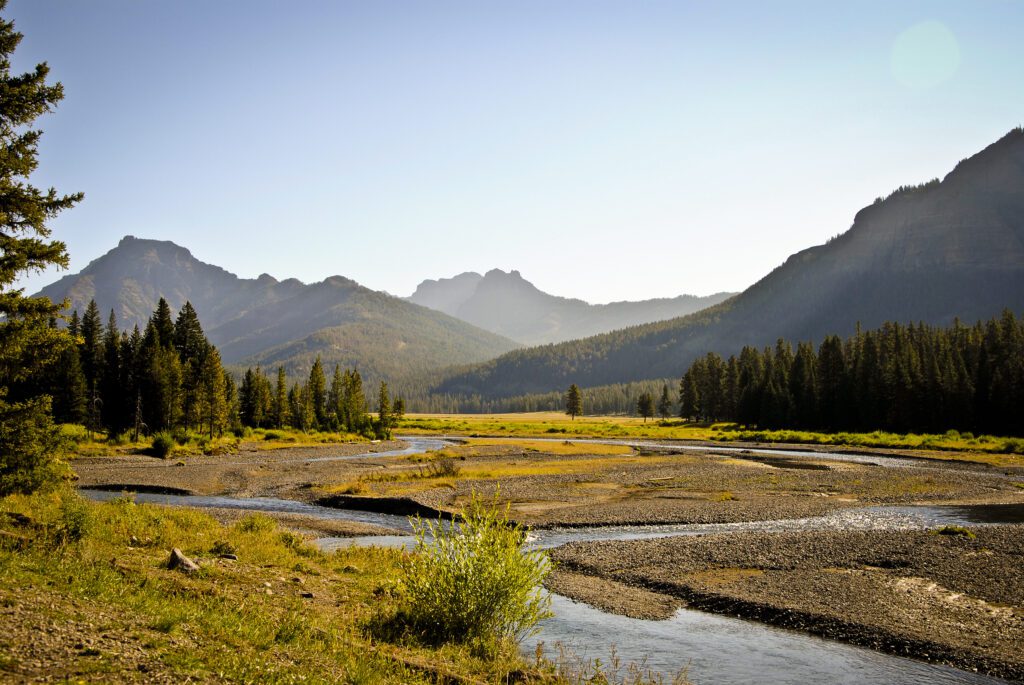
Get an early start to your day and drive to Lamar Valley before dawn. Lamar is Yellowstone’s most expansive basin easily accessed by park roads, and wildlife — especially herds of elk, bison, and wolves — tend to thrive and roam freely here. You’ll find that dawn and dusk are the best times to spot wildlife in the parks as these are the parts of the day when wildlife, especially large mammal wildlife, are most active.

If you’re wondering how to spot wildlife in Lamar Valley and beyond, here are some of our tips.
- Bring a good pair of binoculars! And be patient scanning with them. That’s the best tip we have.
- Look for groups of people or cars. If you see a bunch of cars pulled over or people with wide camera lenses on the side of the road, there’s sure to be some wildlife to spot in the distance. Please be careful and choose a responsible place to pull over. When your car is pulled over, crack or open the windows and turn off the engine. You might be able to hear wolves howling or elk bugling.
- Spotting wolves: Wolves are quite a bit more elusive than bison or moose. If you spot a herd of elk or bison all facing the same way, that’s a pretty good sign that wolves could be near. Winter is the best time to see gray wolves because they pop out more against the white snow. The north part of the park is open to visitors during the winter season, and that’s the best time to come to the park specifically to see wolves.
Hike to Mt. Washburn
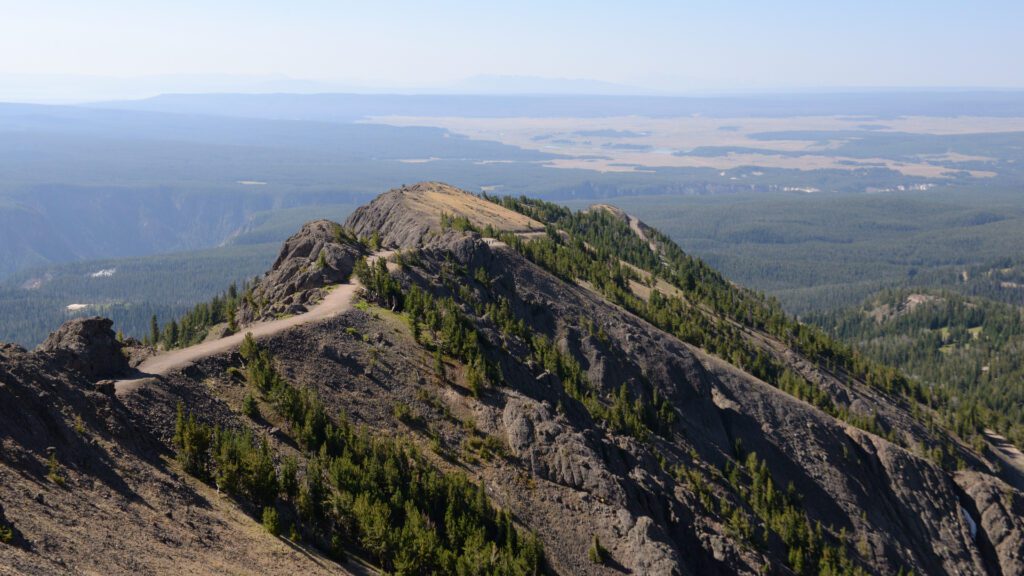
- Length: 6.2 miles from Dunraven Pass trailhead or 5 miles from Chittenden Rd parking area trailhead
- Elevation Gain: 1,400 ft.
- Trail Type: Out & Back
- Difficulty: Strenuous
- Trailhead Location
Panoramic views of 50 miles in the distance at a peak elevation of 10,243 feet, frequent bighorn sheep sightings, and carpets of wildflowers blooming in July are some of the aspects you can look forward to on this hike.
Mt. Washburn is one of three fire lookout stations in Yellowstone, so amongst wildlife sightings, you might even see some firefighters stationed on this peak for the summer. This is the busiest hiking trail in Yellowstone, so be prepared for crowds. However, it is also the hike that presents you with the longest panoramic views across Yellowstone, and we definitely recommend seeing it.
Make sure to check the roads report. This trail may be closed due to ongoing construction on Dunraven Pass.
Grand Canyon of the Yellowstone

The Grand Canyon of the Yellowstone is a must-see, and it’s a great stop to spend your afternoon after hiking Mt. Washburn. The two areas couldn’t be any different, really. Where Mt. Washburn is a towering peak notable for its rich history of fire-watching and lookouts across vast space, the Grand Canyon of the Yellowstone sucks you in with dramatic waterfalls and clouds of mist.
Ever heard of Thomas Moran or Ansel Addams? Both are famous artists notable within the national park movement, and both were extremely drawn to documenting the Grand Canyon of the Yellowstone. You can see the upper and lower falls of the Yellowstone River (the muse of so many photographers and painters like Moran and Addams) by accessing a variety of overlooks.
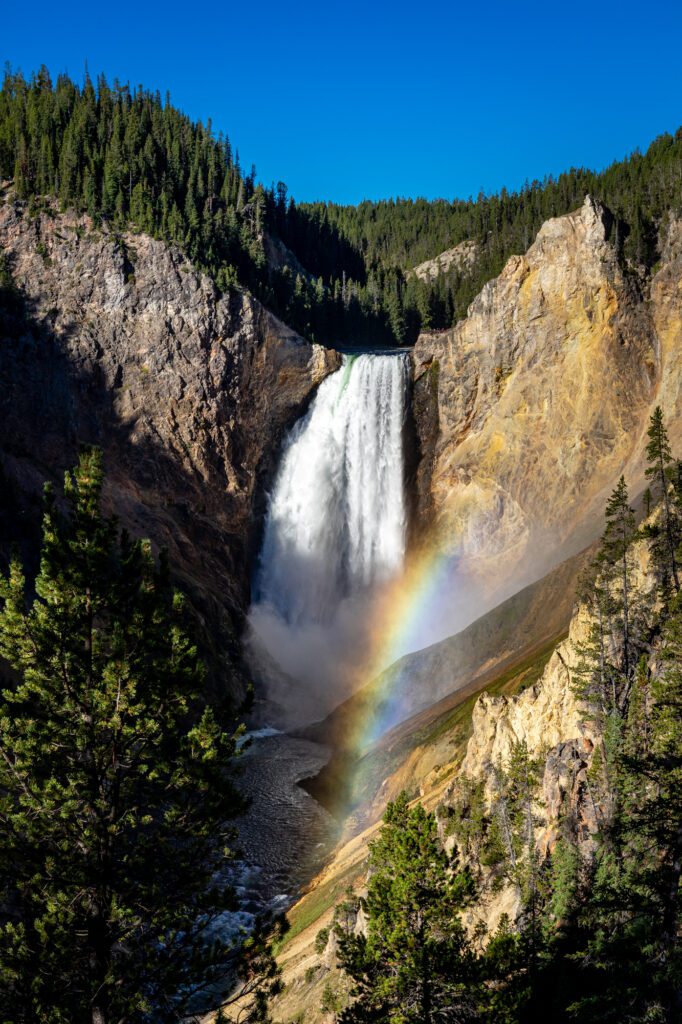
There are also a number of trails that let you partway into the canyon for a better view of the river and the yellow stone this park is named for. We recommend the hike to Point Sublime, a 2.7 mile round-trip hike with 340 feet of elevation gain that takes you past Artist Point and several other majestic views of the canyon.
Hayden Valley at Sunset / Dusk

Hayden Valley is another prime, open plain to plan on stopping at for wildlife sightings. There are always bison herds to be seen in Hayden Valley at most times of the day. However, if you come at dusk you might just get lucky and spot some wolves or a grizzly bear roaming the streams amongst the bison herds.
Also worth mentioning here is that big mammal wildlife are not the only wildlife to prioritize in the parks! Hayden Valley is home to so many waterfowl species like herons, ducks, Canadian geese, and pelicans. They are also very active at dusk.
Where to Stay for the Night
- Canyon Campground: Located inside the park near the Grand Canyon of the Yellowstone, this 273-site campground is located close by to Canyon Village stores and restaurants.
- Canyon Lodge & Cabins: Known as “the largest sustainable lodging in the national parks,” Canyon Lodge has more than 500 rooms and cabins, and is nearby to restaurants, gift shops, and other amenities
Day 3: Old Faithful, Grand Prismatic, and Firehole Lake Drive
A classic Yellowstone adventure wouldn’t be complete without a trip to see Old Faithful, arguably the most famous feature of the park. This itinerary for Day 3 gets you to Old Faithful first thing in the morning, leaving the rest of the day for more hot spring, waterfall, and wildlife spotting.
Old Faithful
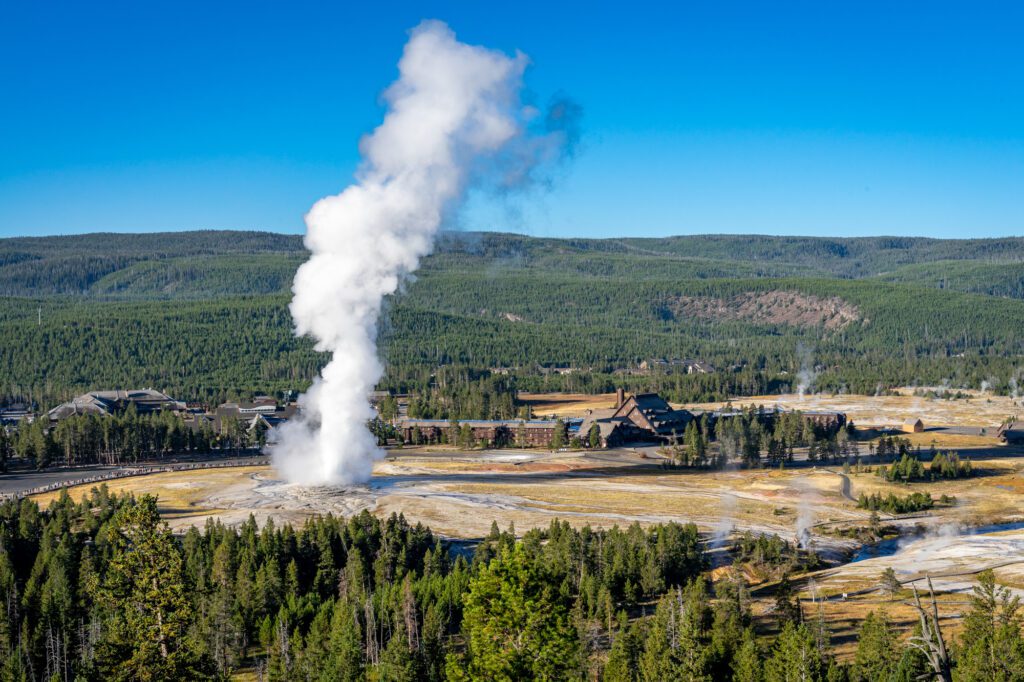
This cone-geyser is aptly named due to its predictable pattern of eruptions — which occur every 45 minutes to two hours. Every time it erupts, it shoots boiling water 130 feet into the sky. It’s as faithful as can be, and we wouldn’t tell you to visit unless it was a transformative stop.
This is one feature of the park that you might want to time out on a more exact schedule. Earlier is better here because this attraction really draws crowds. You can find a report of eruption predictions for Old Faithful and surrounding geysers by visiting the NPS site on Old Faithful.
We recommend checking out these predictions the evening before venturing to Old Faithful. If you miss the eruption you wanted to see, no biggie, another eruption will usually occur in 45 minutes.
You can watch from boardwalks that circle the geyser, or from an observation viewpoint above. We watched from the Yellowstone Observation Point during the early morning with our cowboy coffee, and we thought it was the perfect deck to watch the eruption from.
To get to the Observation Point, park at Old Faithful Village. You’ll hike 1.5 miles round trip and gain 260 feet of elevation gain to see the geyser from above, with views of the historic Old Faithful Inn in the background.
Upper Geyser Basin
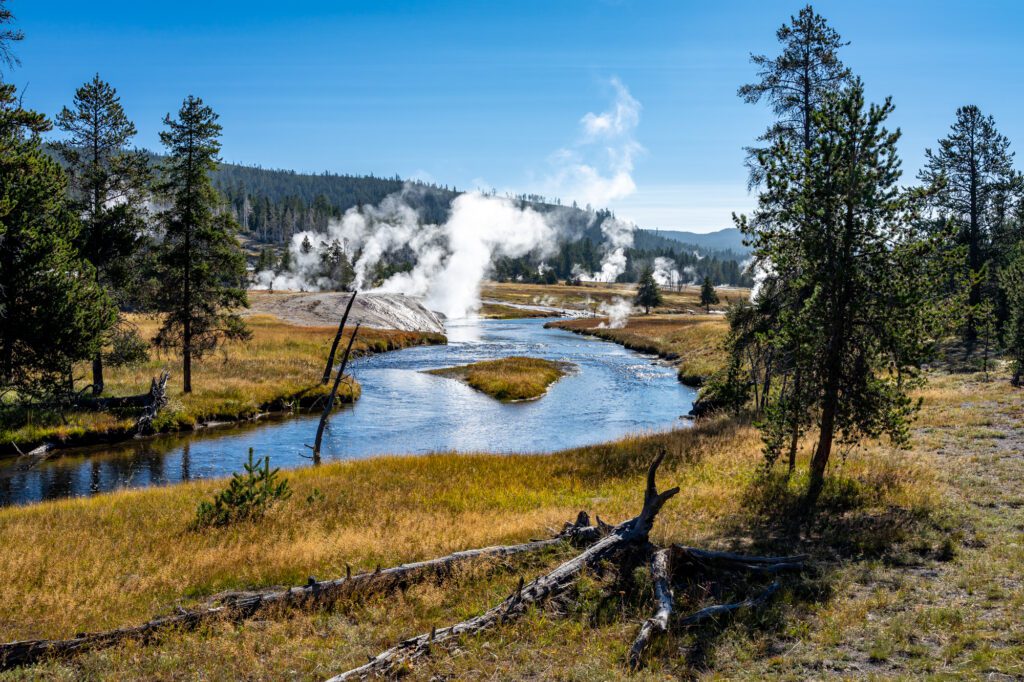
Nearby, the geysers and hot springs in Upper Geyser Basin are truly iconic. The trail from the Visitor Center takes you on a 4.9 mile loop with 350 feet of elevation gain around all the sights. You’ll walk on a mixture of dirt trails and boardwalks, and have the chance to see not only the geothermal features, but plenty of birds nesting in the lodgepole pines in this basin.
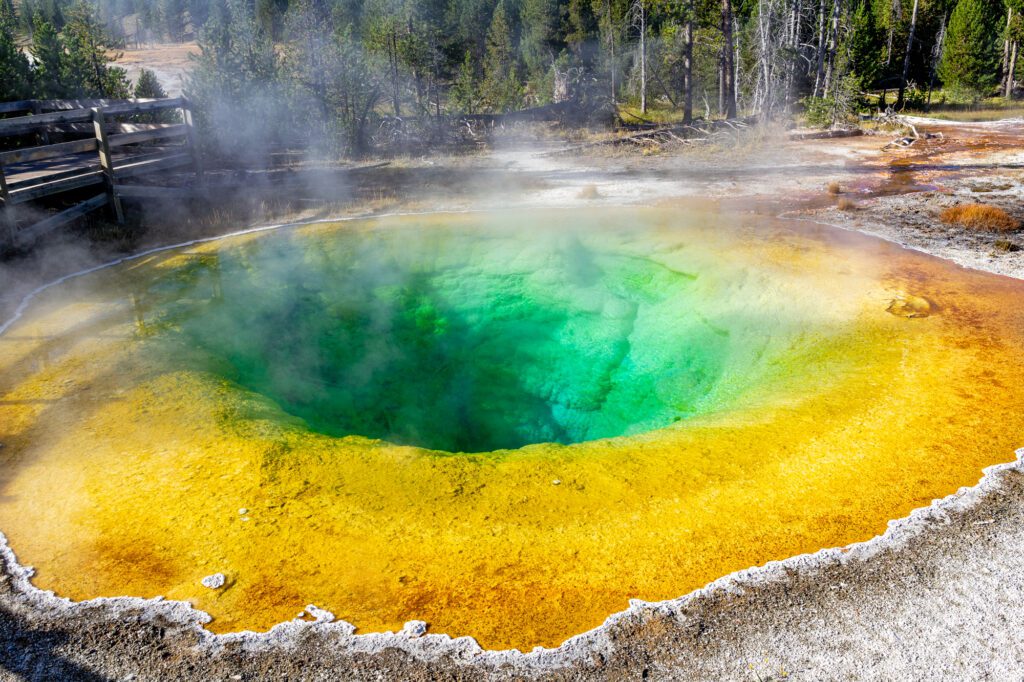
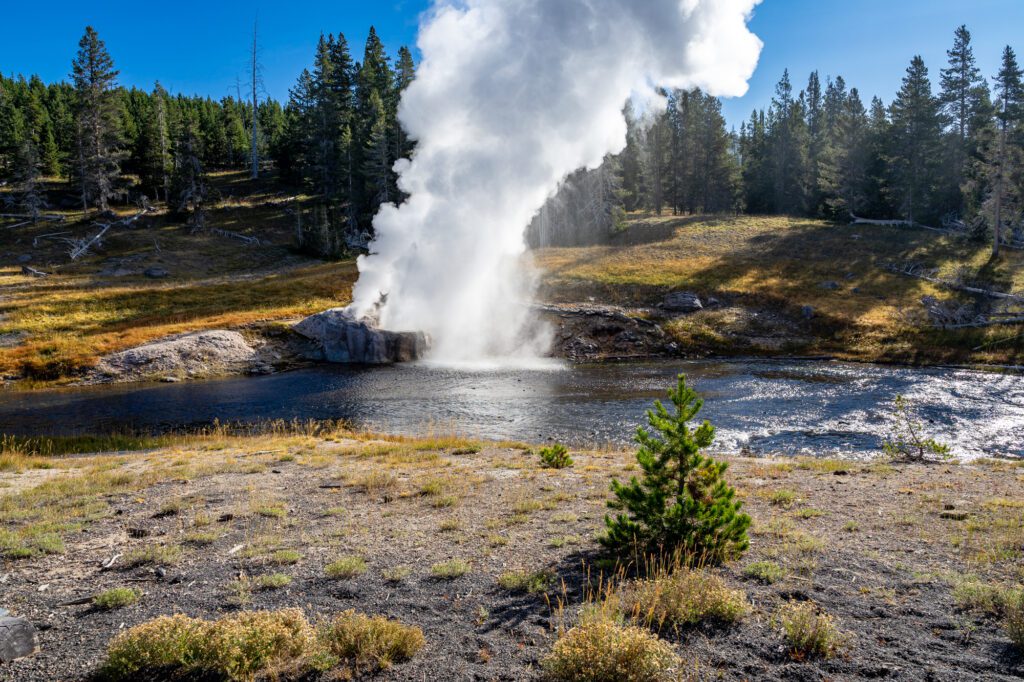
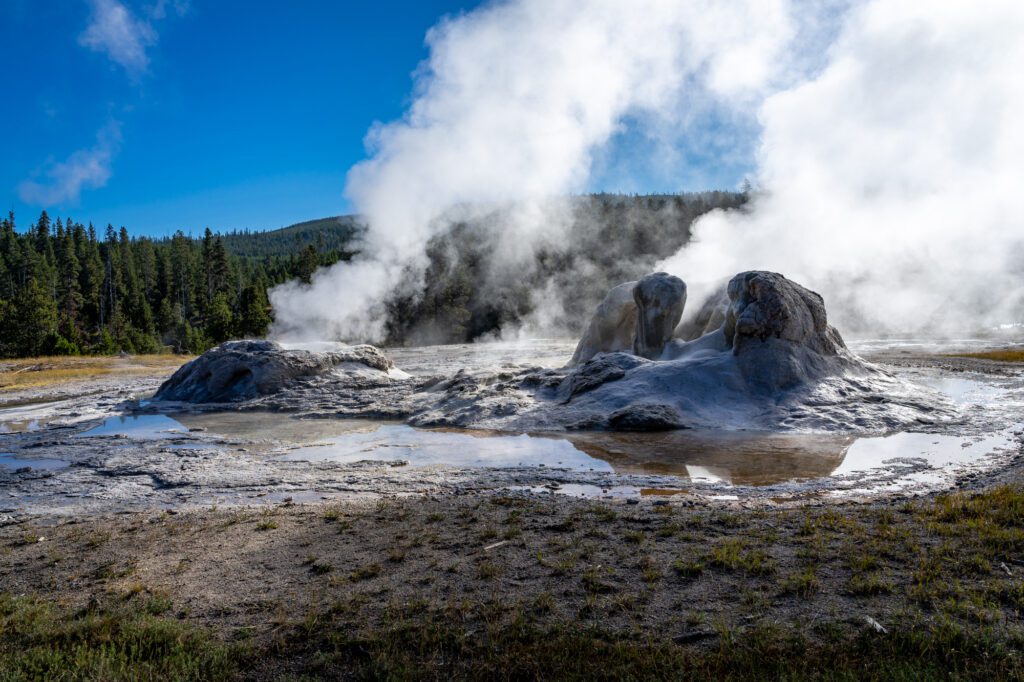
We’ll list the classics here, and the attractions we loved the most:
- Chromatic Pool: A hot spring with all the colors of the rainbow.
- Grotto Geyser: A fountain-like geyser that looks like contemporary art.
- Riverside Geyser: This geyser makes actual rainbows! It shoots water 70 feet into the air in an arc across the river.
- Castle Geyser: Another cone geyser similar to Old Faithful and Grotto Geyser.
- Morning Glory Pool: A stunning green-yellow hot spring that appears very deep and mysterious to any onlooker.
Grand Prismatic Overlook

This is a very short 1.2 mile out-and-back trail that we can hardly call a hike, though the viewpoint at the end is something you would expect only a lengthy hike could lead to. This overlook presents you with an amazing view of Grand Prismatic Spring, a very large rainbow-colored spring which is also iconically Yellowstone.
Yellowstone has so many iconic features, it’s difficult to choose one. If you thought you were joyously overwhelmed visiting Old Faithful and the other geysers and pools of the Upper Basin, Grand Prismatic Overlook will impress you beyond belief. You can also drive to the Midway Geyser Basin trail to visit Grand Prismatic and walk on boardwalks around the feature if you want to examine the otherworldly textures and colors up close.
Hike to Fairy Falls
- Length: 5.4 miles
- Elevation Gain: 170 ft.
- Trail Type: Out & Back
- Difficulty: Moderate
- Trailhead Location
If you keep on the trail after visiting Grand Prismatic Overlook, you’ll have the opportunity to see Fairy Falls, a renowned 200-foot waterfall. It’s definitely a favorite hike of ours, mellow the whole way and winding through multiple meadows with plenty of wildlife sightings.
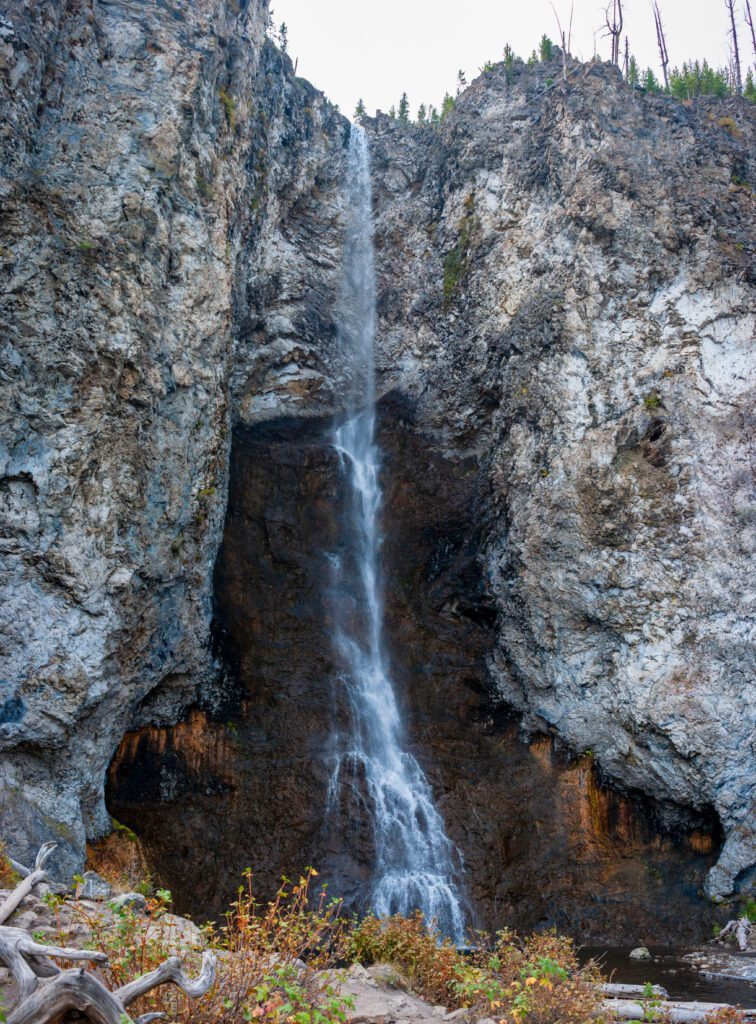
This trail is good for all skill levels but might take a bigger chunk of the day (three to five hours) to complete. Plan accordingly!
Firehole Lake Drive

If you haven’t gotten your fill of geothermal springs in for the day, you can always detour to Firehole Lake Drive on your way to a campsite or lodge. You don’t even have to leave your car to see these springs, so they are the perfect final adventure for this packed geothermal-themed day.
Firehole Spring is another of the multi-colored springs we couldn’t get enough of, but Surprise Pool is something else altogether—it’s deep, deep blue and appears intimidatingly deep. There are about four more geysers present on this drive as well, and two fiery-colored hot lakes.
Where to Stay for the Night
Now that you’re firmly in the south end of the park, it makes sense to stay in a new place to minimize driving.
Stay around Old Faithful (there are three park lodges) or in the town of West Yellowstone, which is outside the western entrance and is the best town in terms of hotel selection and amenities around Yellowstone’s border.
Inside the Park
- Old Faithful Inn: Located within the park right by Old Faithful, this lodge was designed by Robert C. Reamer and built in the winter of 1903–1904. It’s one of the few remaining log hotels in the United States. Think “The Shining”, but with geysers.
- Madison Campground: This campsite is located 16 miles North of Old Faithful, but would be your best bet for camping in the area, and closer than any other campgrounds within or outside the park. There are bison that occasionally roam through the meadows adjacent to this campground.
Outside the Park: West Yellowstone
- Explorer Cabins: Drool-worthy cabins with kitchenettes just five minutes from the west entrance of the park
. - Faithful Street Inn: Rustic cabins with kitchens and plenty of space for groups.
- The Evergreen: A nice, affordable hotel with historic charm
Day 4: West Thumb Geyser Basin, Yellowstone Lake, and Elephant Back Mountain
Day 4 is going to feel like a good rest day after all the activity in Day 3. Still, you’ll get to see more Yellowstone hot spots: West Thumb Geyser Basin, Yellowstone Lake, and Elephant Back Mountain.
West Thumb Geyser Basin

This is the largest geyser basin on the shores of Yellowstone Lake. There are plenty of geysers above the shoreline that you can see via more boardwalks and trail systems (like Upper Geyser Basin), but we bet you didn’t know there are geyser eruptions occurring every day under the water as well. Do you dare sink a toe in Yellowstone Lake?
Yellowstone Lake
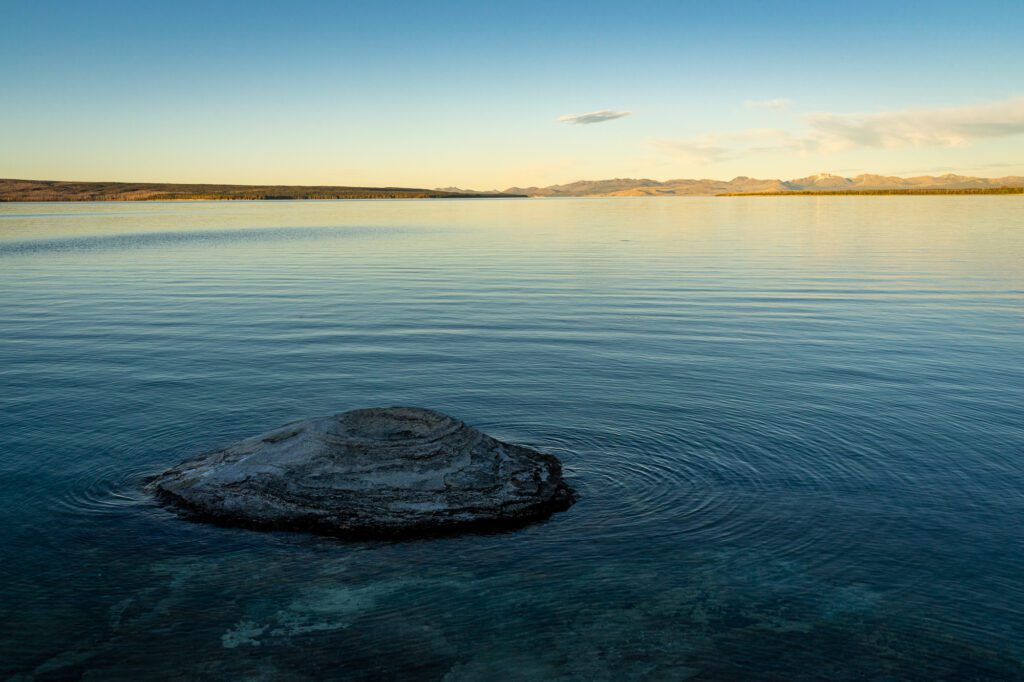
Yellowstone Lake is a massive lake — the largest high elevation lake in North America. And though the water is bitter-cold and glacial in some parts, in others it is very warm and even boiling. Visitors are welcome to swim or recreate in some parts of the lake, though other areas are off limits. For more information on which beaches have tourist access, see the NPS site.
Hike Elephant Back Mountain
- Length: 3.5 miles
- Elevation Gain: 800 ft.
- Trail Type: Lollipop
- Difficulty: Moderate
- Trailhead Location
Elephant Back Mountain Trail is another hike to a stunning panoramic viewpoint of the park. This time, you’ll be treated to views of Yellowstone Lake from above.
This hike travels through some meadows with wildflowers, though the majority of the way you’ll be hiking through pine forests. We recommend it to most or all hikers, as it’s shorter and has less elevation gain than some of the other hikes on this list.
Where to Stay for the Night
The best place to stay for the night in terms of convenience is going to be around Lake Yellowstone. Staying there will help you avoid backtracking and set you up nicely for the morning drive to Grand Teton.
However, it’s super competitive to get spots there, so you could also stay at Old Faithful again, or in West Yellowstone. Just be prepared for some extra driving in the morning.
- Grant Village Lodge: A mid-size lodge located within the park, built in the 80s and named after Ulysses S. Grant.
- Grant Village Campground: Campground with facilities associated with Grant Village lodge.
- Lake Yellowstone Hotel: Massive and classic hotel located on the shores of Yellowstone Lake. Straight out of a Wes Anderson film.
Day 5: Rockefeller Highway to Grand Teton, Mormon Row, and Oxbow Bend
On Day 5 of your journey, say goodbye to the geothermal activity of Yellowstone. You’ll drive on Rockefeller Highway down to Grand Teton National Park to hike the mellow String Lake loop, view the historic Mormon Row settlement, and catch the sunset at Oxbow Bend.
Driving from Yellowstone to Grand Teton via Rockefeller Highway
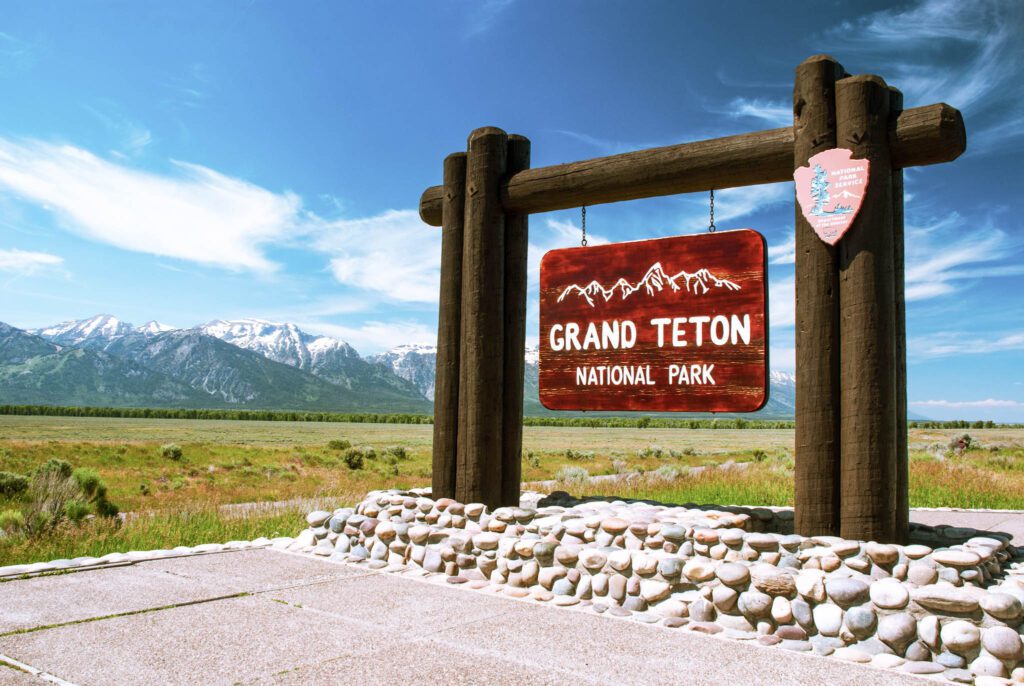
Rockefeller Highway is a scenic highway that connects Yellowstone and Grand Teton. On the thirty miles of highway between the parks, you’ll have views of the approaching Tetons and will probably be able to spot more wildlife — antelope, deer, and other mammals that roam the plains. Feel free to stop for a breakfast picnic on any of the pull outs along the way. Our favorite is Jackson Lake overlook, on the last leg of the highway before you reach Jenny Lake and String Lake.
Hike String Lake
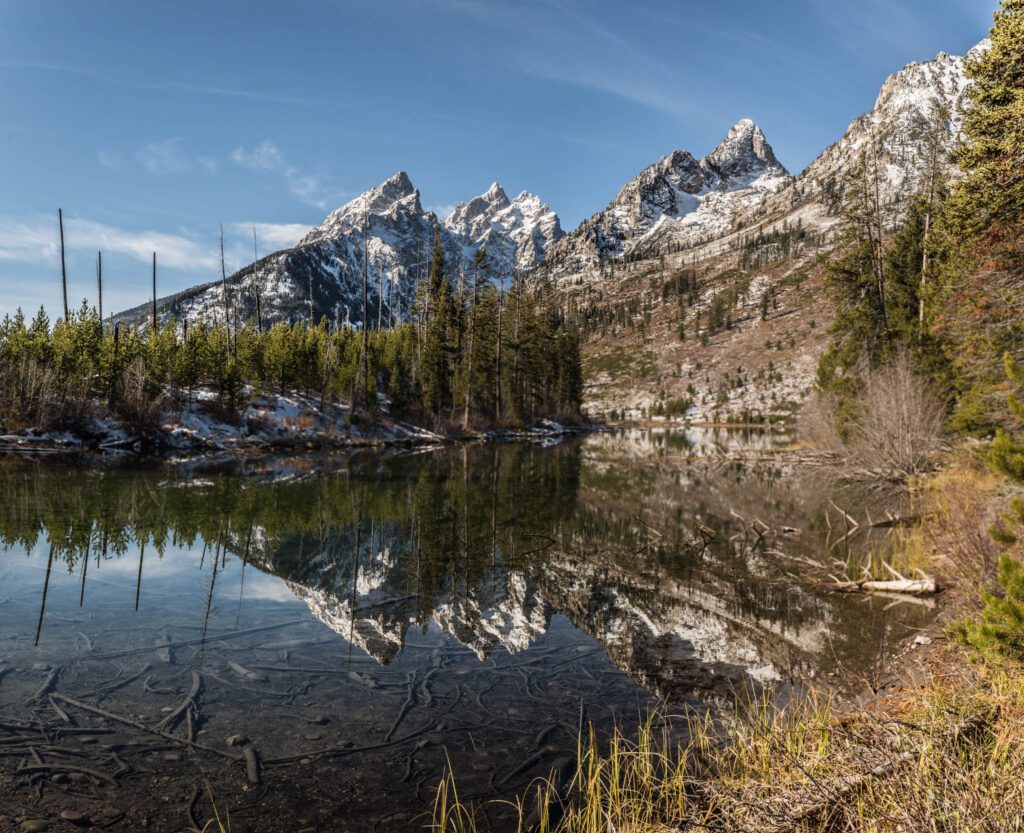
- Length: 3.7 miles
- Elevation Gain: 291 ft.
- Trail Type: Loop
- Difficulty: Easy
- Trailhead Location
String Lake is a moderately-short, easy hiking loop that we would recommend to any level of hiker.
Because it is shallower than most lakes in Grand Teton National Park, this is the hike we would say we have spotted the most moose on while visiting both parks. Moose love soaking in shallow waters on their stilt-like legs, chomping on river and lake foliage. It’s also quite easy to spot lake trout in the shallows of the water on this hike, especially with a good pair of polarized sunglasses.
Mormon Row

These are the remaining homesteads of the Mormon settlers that came to live at the base of the Tetons in the 1890s. You’ll have the chance to walk around some truly historic barns, irrigation ditches, and the Chambers Homestead complex.
This is also another great site to bring binoculars and look for herds of bison in the distant plains beyond Mormon Row. This is a good spot for late afternoon when it starts to cool down during the summer.
There isn’t much shade, but the wind does get a bit breezy here. Also, a lot of painters choose to landscape paint from this spot, so you can look forward to potentially viewing some art mid-creation.
Sunset at Oxbow Bend
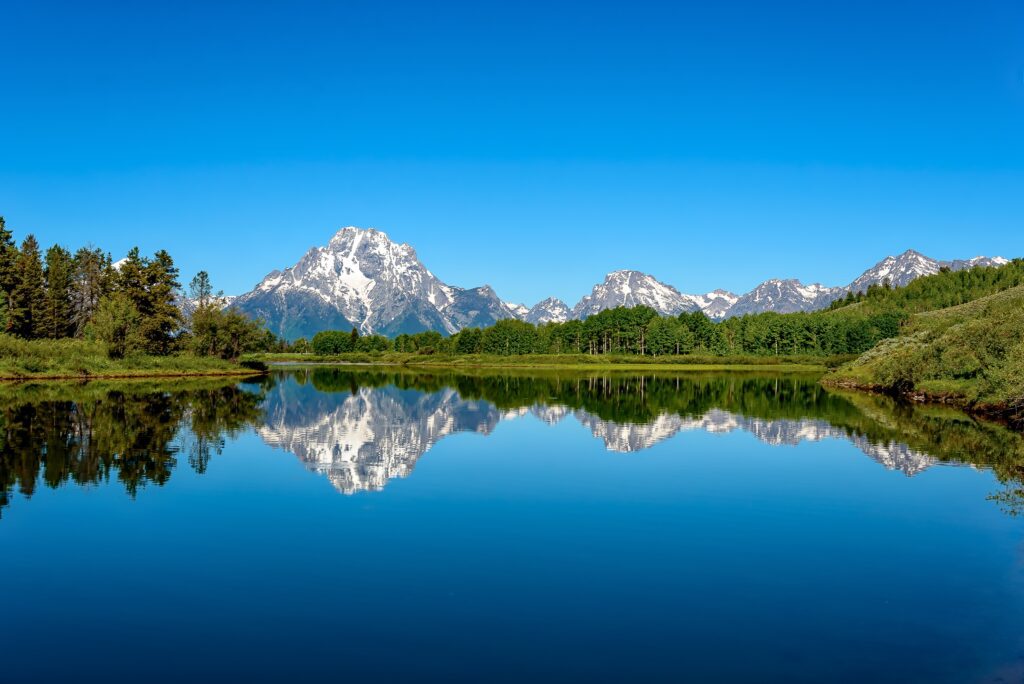
Back to your regularly scheduled programming of more iconic viewpoints: Oxbow Bend is one of the best spots in the park to view Mt. Moran and the Tetons, and a horde of wildlife. Especially at sunset, you’ll have the chance to see and hear birds and waterfowl, moose, bears, and elk. It’s one of the most serene spots on this itinerary, and it will really refresh you for your final two days.
Where to Stay for the Night
We’ll reiterate here and recommend that you stay at the same campsite or lodge for your entire stay in Grand Teton. It’s only two nights, and Grand Teton is a lot smaller than Yellowstone, so it will be nice to have a central home base. You can find a full list of our recommended areas to stay at the top of this itinerary.
Inside the Park
- Campsites at Signal Mountain or Jenny Lake.
- Signal Mountain Lodge: A rustic, semi-luxury lodge offering rooms and bungalows, as well as dining and other activities.
- Jenny Lake Lodge: Luxury lodge located on Jenny Lake, with great access to Cascade Canyon or other hikes with ferry access.
Outside the Park
- The Wort: A historic boutique hotel located in the heart of Jackson.
- Flat Creek Inn & Mart: Motel located right above the Elk Refuge, grounds designated for elk herds between Jackson and Grand Teton.
- Dornan’s: Located right outside the Moose entrance of Grand Teton, this lodge offers spacious rental cabins that are ideal for groups.
Day 6: Sunrise Wildlife Drive, Hike Cascade Canyon, and Sunset Wildlife Loop
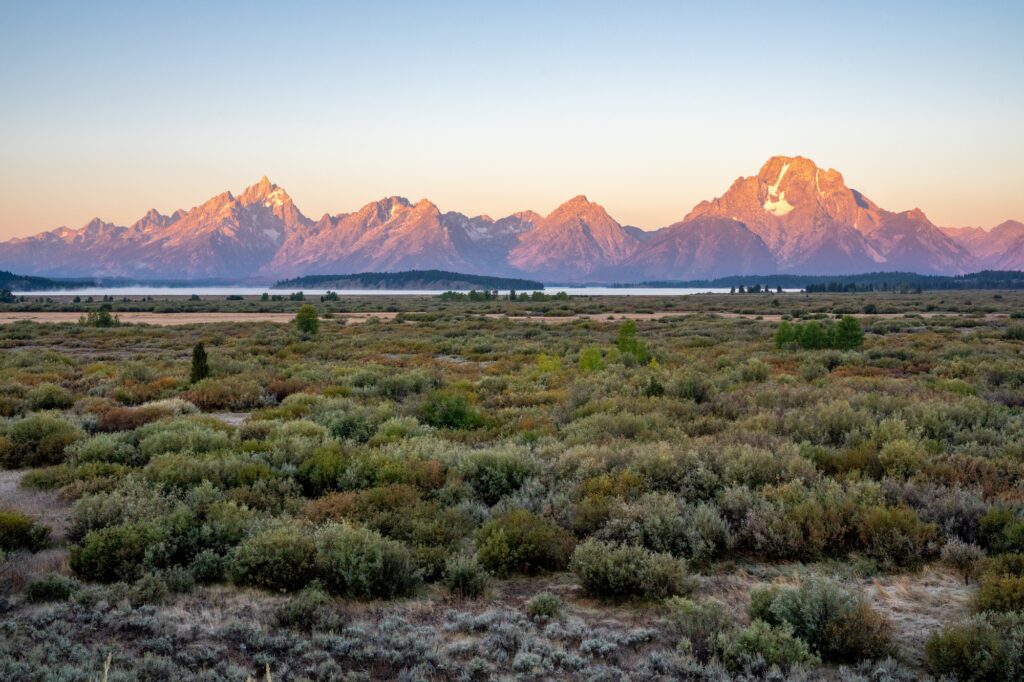
Today, bookend one of the best hikes in Grand Teton National Park with a sunrise and sunset wildlife drive.
Sunrise Wildlife Drive on Moose Wilson Road
Waking up at sunrise to do a wildlife safari within the park is a sure way to spot majestic bears, elk, wolves, and moose that thrive especially at dusk and dawn.
We recommend driving on the Moose road towards Phelps Lake for your early-morning safari.
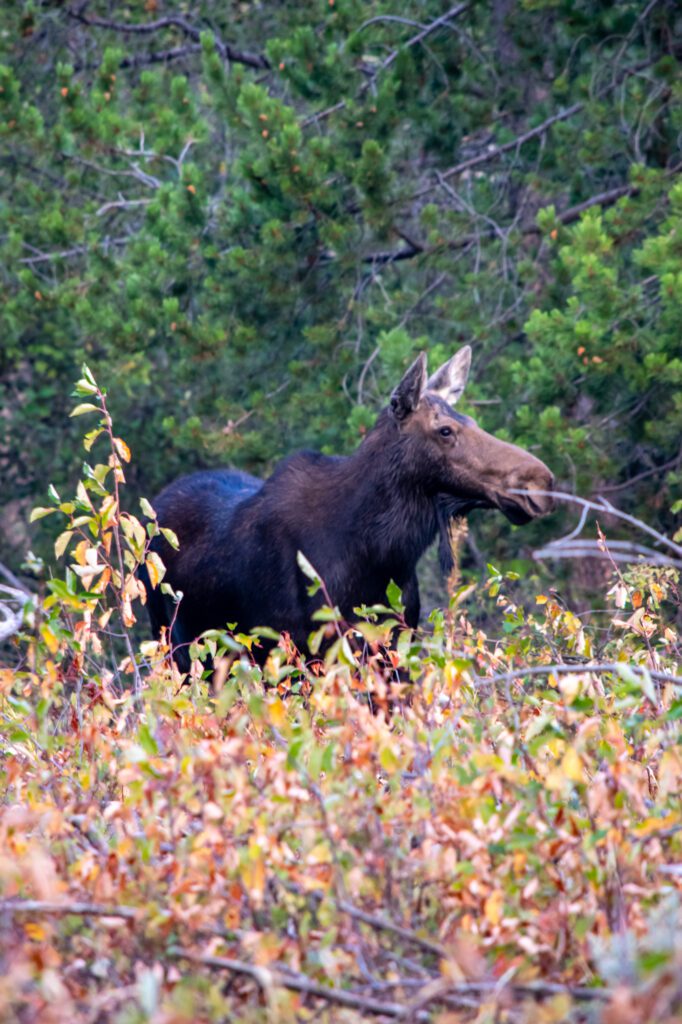
Beware that the road is unpaved and somewhat unmaintained. Because it’s a less-traveled route, we think wildlife are more apt to hang out around it.
On one of the first pullouts (this one), we saw multiple moose, a baby moose, and a bear and three cubs. All by breakfast time!
Hike Cascade Canyon

- Length: 9.1 miles from ferry dock
- Elevation Gain: 1,102 ft.
- Trail Type: Out & Back
- Difficulty: Moderate – Hard
- Trailhead Location
Grand Teton is known for its hikes, and Cascade Canyon is one of the best in the park.
Cascade Canyon Trail begins at the west dock of Jenny Lake, accessed by a 10 minute, $10-per-way ferry ride. The trailhead takes you up past Hidden Falls and Inspiration Point, and then on towards the Cathedral Group of Teton Mountains (the Grand Teton, Mt. Owen, and Teewinot).
On this hike, you’ll walk along a grand river the entire way, spot a few waterfalls, huckleberry fields, and probably some moose along the way, too. We spotted five moose here on our last excursion to the park.
If you choose to skip the ferry ride, this hike will be 14.6 miles round trip from Jenny Lake Visitor’s Center, with approximately 1,300 feet of elevation gain.
Sunset Wildlife Loop
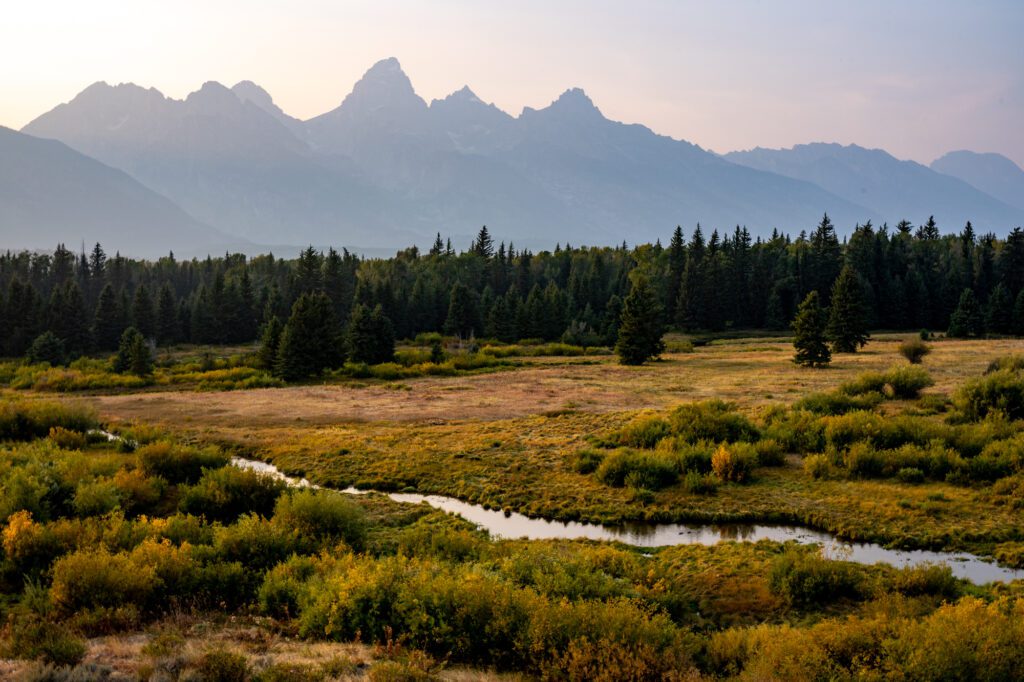
About two hours before sunset, drive up Hwy 191 from Teton Park Road. You can pull out on any of the designated stops, but we recommend stopping at Blacktail Ponds, Schwabacher’s Landing (for beavers and otters!), Snake River Overlook, Oxbow Bend, and Willow Flats Overlook.
Again, make sure you bring binoculars and turn off your engine so you can hear bugles, howls, or waterfowl calls. You can even bring a blanket and make a sunset picnic spot on any of these stops, waiting for the stars to emerge on your final night in this magnificent park.
Day 7: Phelps Lake, Laurance S. Rockefeller Preserve, and Catch Flight Home
All good things have to come to an end, but this final day will really leave you feeling bitter-sweet. You’ll get in one last hike in Grand Teton, have the chance to explore the exhibitions at Laurance S. Rockefeller Preserve, and then you’ll be on your way!
Phelps Lake Loop
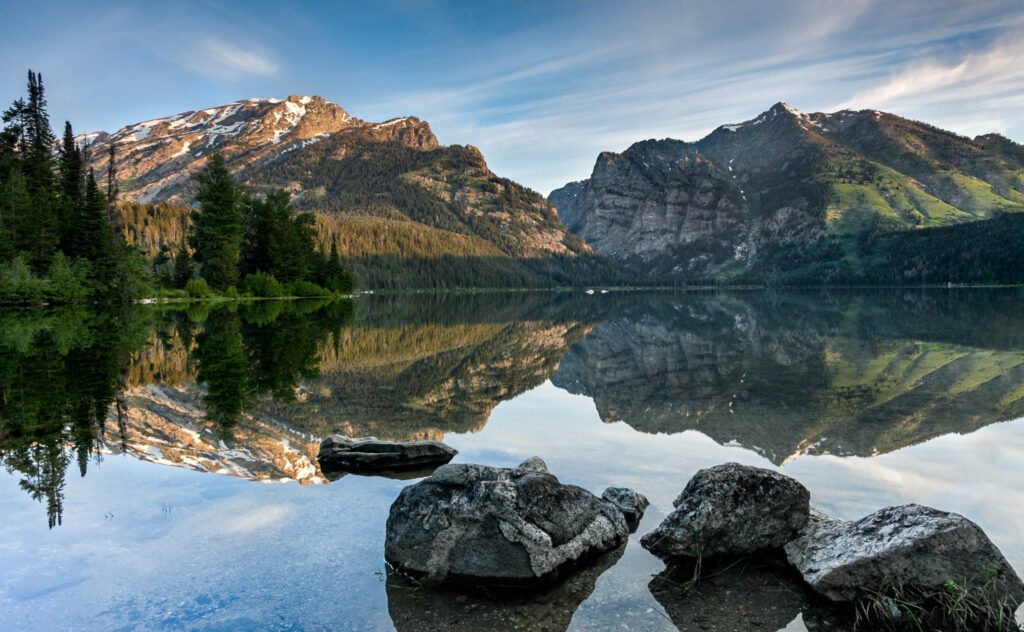
- Length: 7 miles
- Elevation Gain: 475 ft.
- Trail Type: Loop
- Difficulty: Moderate
- Trailhead Location
From the Laurance S. Rockefeller Preserve Center, the trail enters a forest and eventually (roughly 0.25 miles from the parking lot) comes to a junction where hikers can choose either the Woodland Trail or Lake Creek Trail. The Woodland trail, which heads counter-clockwise around Phelps Lake, is the most direct trail to the lake loop, and is also the most scenic.
Located on the northeastern shore of Phelps Lake is an iconic and popular jumping rock with super views of Death Canyon. The jump entails an exhilarating thirty-foot drop into cold mountain water. If you choose to partake in the jump, make sure someone snaps a photo of you midair.
Laurance S. Rockefeller Preserve Center
Phelps Lake Loop begins and ends at the Laurance S. Rockefeller Preserve Center, originally a dude ranch known as JY Ranch. Visitors can learn about Rockefeller’s conservation philanthropy, historical ranch history, and sensory exhibits on plants and wildlife.
We recommend stopping in before you leave the park, as it’s a great educational way to wrap up a week-long trip seeing all this natural wildlife and foliage.
Head to the Airport
Head out to the airport to catch your flight home in the afternoon. We’ve flown in and out of Jackson countless times, and each time feels a bit more magical. It’s a bittersweet ending to this jam-packed trip to Yellowstone and Grand Teton National Parks.
What to Do with More Time: 8-10 day Yellowstone and Grand Teton Road Trip
If you have extra time, we wouldn’t necessarily recommend doing or driving more than the amount on this list. Instead, try to have a quality-over-quantity mindset and spread the activities on this list over a few more days. We also recommend trying some local activities that you wouldn’t normally get the chance to do. Here are a few of those activities we can recommend:
Additional Hikes in Grand Teton
Yellowstone has so many pit stops and a few really good hikes, but the hikes in Grand Teton are really prolific and quite strenuous — and they always have a magnificent end-point attraction worth the journey.
We’ve done most of them — from Delta, Surprise, and Amphitheater Lakes, to Inspiration Point, Hidden Falls, and the Jenny Lake loop.
Visit our guide on the 9 Best Hikes in Grand Teton National Park to plan out another day hike or two if you have extra time to spare.
Bike Rentals
Renting bikes and seeing either park by bicycle for a day is a great way to not only slow down and have the chance to spot more wildlife, but give yourself a break from the constant traffic and crowds you might run up against in parking lots during peak summer months.
There are bike path systems throughout both parks, and both parks present cyclists with inspiring views of mountains, rivers, and valleys.
- Old Faithful Snow Lodge: The bike shop staff in Yellowstone can give you insight on nearby path routes. They offer hybrid bikes in addition to regular road bicycles, and also have helmets, racks, gloves, hip packs, and other biker-friendly gear available to rent.
- Teton Mountain Bike Tours: Not only can you rent bikes and gear from this shop located in Jackson Hole, but you can also book guided day and multi-day tours in the park. We’ve heard really good things about this company, but there are countless other bike rental shops in Jackson to choose from, so you shouldn’t have any issue renting bikes for a day or two!
Horseback Riding
Touring the parks on trail horses is another great option for skipping crowds. You’ll get to experience trail systems from a completely different perspective.
- Yellowstone National Park Lodges offers partial day tours (one – two hours) through meadows, canyons, pine forests, and along streams within the park.
- Grand Teton Lodge Company offers trail rides from the corrals at Colter Bay Village, Jackson Lake Lodge, and Headwaters Lodge and Cabins within the park. They are also one to two hour long rides through wildflowers and vistas of the Tetons. The wranglers also give guides on history and wildflowers.
Fishing Guides
Yellowstone and Grand Teton have some of the best fly-fishing culture in the world, and the rivers are plentiful with trout.
- For a list of authorized fishing guides available for hire in Yellowstone, visit the Yellowstone NPS fishing site here.
- For a list of authorized fishing guides available for hire in Grand Teton, visit the Grand Teton NPS fishing site here.
Rent Paddle Boards, Kayaks, or Canoes
Yellowstone and Grand Teton are both home to massive glacial lakes and prolific sources of water. What better way to spend an extra day than renting water sport equipment or booking a tour and getting out on Jackson or Yellowstone lake?
- Yellowstone Hiking Guides has a 4 hour sea kayaking tour on Yellowstone Lake, with five miles of kayaking to see geysers and wildlife on shore.
- Rendezvous River Sports has always been the go-to water-sport rental outfitter in Jackson. They rent kayaks, canoes, paddle boards, rafts, surfboards, and more, and also have options for guided tours in BOTH Yellowstone and Grand Teton.
What to Do with Less Time: 5 day Yellowstone and Grand Teton Itinerary
If you must make this trip shorter, we recommend skipping Day 2 (Lamar Valley, Mt. Washburn, Grand Canyon of Yellowstone, Hayden Valley) and Day 6 (Sunrise Wildlife Drive, String Lake, Mormon Row, and Sunset Wildlife Loop) of this itinerary.
You could easily add a sunrise or sunset drive onto your first and last days in Grand Teton. And, it isn’t too far to the Grand Canyon of the Yellowstone, so if you really need to see the falls and the canyon, that could warrant a short visit in place of an activity on the 3rd day of this itinerary.
Tips for Your Trip
Here are a few things to keep in mind for your Grand Teton and Yellowstone itinerary.
National Park Pass vs. Pay-per-Day
You will need to pay for entry into these parks. An America the Beautiful Annual Pass (which gets you into any national park and also covers parking fees at most national monuments or national forest trailheads) is $80, and a single day pass into any national park, per vehicle, is $30. We think it’s definitely worth it to get an annual pass for this trip, especially if your lodging is located outside the parks.
Parking and Crowds
Because Yellowstone and Grand Teton National Park are two of the most visited in the US and there is limited parking, we recommend that guests that want the best accessibility to the parks arrive early in the morning (9:00am at the latest).
Arriving at these parks midday during peak summer months can mean a headache, waiting in lines for parking slots to open up.
We have compiled some great guides for sunrise drives on this itinerary to get you in the park as early as possible — they will not only let you avoid mass crowds and the heat of the day, but will present you with the best opportunities to see wildlife like wolves, moose, and bears.
Elevation Acclimation and Altitude Sickness
There is quite an extreme elevation in the park (6,800 feet at the valley floor of Grand Teton, and Yellowstone is even higher), so many of the hikes on this list have significant elevation gain, and visitors should be wary of trying high-altitude strenuous hikes without acclimating to the elevation first.
Symptoms of altitude sickness include nausea, headaches, and shortness of breath. A general good rule is to take it easy and do some less strenuous hikes in the area before trying to ascend or summit anything.
Gentle lake loops or spots of interest that don’t require much activity or additional elevation gain, like the ones on this itinerary, would be perfect!
Wildlife Safety
Bear spray is a necessity while in Yellowstone and Grand Teton. You should have basic knowledge on how and when to use bear spray, and keep it within easy access on the side or front of your pack or belt.
If this is a one-off trip or you’re flying into the parks, we recommend renting bear spray.
- Teton Backcountry Rentals in Jackson, Wyoming rents bear spray for $8 a day.
- Explore Rentals in Bozeman is conveniently located near the airport and offers bear spray rentals and free tutorials.
In addition, making noise or carrying a bear bell, especially while traveling through huckleberry patches, is a great way to alert nearby wildlife that you are passing through. Wildlife are a lot less likely to spook, charge, or maul if they are aware of nearby hikers.
Bears are not the only dangerous animals in Yellowstone and Grand Teton. There have been many tragedies for both humans and animals within both parks — especially in recent years.
Please respect wildlife and do not approach moose, elk, bears, wolves, or bison at all. A general rule is to not interact with any wildlife — including feeding small critters like chipmunks. Feel free to take pictures and observe (that’s half the experience of visiting the parks!) but do so from a very safe distance.
Leave No Trace
Lastly, it’s always important to practice Leave No Trace principles. Conservation is a massive issue of philanthropy and federal protection in and around these parks, though folks sometimes forget that the smallest actions also add up and can affect local ecosystems. Especially with wildlife living on and around the same trail systems that hikers use, we urge you to please make sure to pack in what you pack out.
Road Conditions
We just came back from the west and went to Grand Teton for a day trip. The Moose Wilson road that leads to Phelps Lake was a disaster. It took us forever because of how many deep potholes there were, and we had a truck. Always make sure to check road conditions for closures or hazards (here).
Getting to the Parks
To get to these two national parks, you have a couple of options. If you live close by – Salt Lake City, Denver, or Idaho, for example – you can drive to the starting point in Bozeman. Otherwise, flying in is the way to go.
Driving In
Yellowstone and Grand Teton are both surrounded by vast amounts of open space. The two closest major cities with travel hubs and amenities are Salt Lake City and Denver.
From Salt Lake City
Distance: 281 miles to Grand Teton
Time: 4 hrs 45 mins
Route: The fastest route takes you up the western border of Wyoming, through Evanston, Afton, and Alpine on I-80 and route 89.
From Denver
Distance: 480 miles to Grand Teton
Time: 7 hrs 45 mins
Route: The fastest route takes you through Fort Collins, CO, and into Wyoming through the western towns of Laramie, Lander, and Dubois.
Flying In
Because driving from any city that is further out will require extra commute travel days, we think the best way to do this trip is flying into Bozeman and flying out of Jackson (or the reverse). Bozeman and Jackson have bookending airports to these national parks.
Alternatively, you can plan an out-and-back trip from one airport (e.g. fly into Bozeman, do two days in Yellowstone, three days in Teton, two days in Yellowstone, return to Bozeman airport). However, that will probably add a lot more driving time to this already jam-packed road trip.
If you do plan to only fly into one of the airports, we would recommend Jackson Hole Airport. It’s a 1.5 hour drive from Bozeman’s airport to the entrance of Yellowstone National Park, possibly made longer depending on traffic. From Jackson airport there is no commute — it’s the only commercial airport located within a national park.
West Yellowstone, located at the west entrance of the park, has a smaller airport that you could also check in to for flights. However, the flight selection is limited.
One other option that we don’t necessarily recommend would be to fly into Salt Lake City International Airport and drive to the parks from there, though that adds an additional five hours each way onto this already exhaustive adventure. If you have the time and are looking for a longer road trip, that might be a great option for you! If not, fly straight to the source.
When to Visit Yellowstone and Grand Teton
Generally, the best time to visit Yellowstone and Grand Teton is between May and October.
These parks are both consistently busy between Memorial Day and Labor Day, so if you want to experience them with less people, traffic, and commotion, it’s generally a good idea to travel before June or after September.
Early fall and late spring are definitely our favorite times to visit these parks, with trees in full fall glory or budding spring bloom, and active wildlife taking advantage of the last or first of the summer season.
That said, roads begin closing and trails can become impassable late October through April. You can still visit these parks during the winter season, though there will be a lot less to do, especially for activities on this itinerary for Yellowstone and Grand Teton.
That’s all folks — thanks for tuning in!
